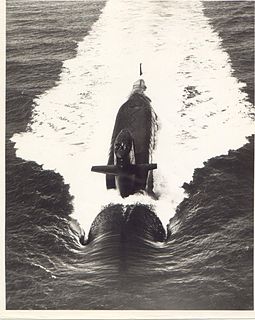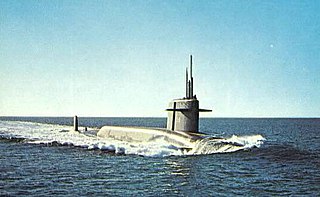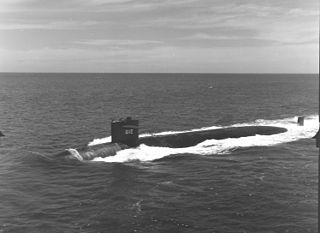
USS Blueback (SS-581) is a Barbel-class submarine that served in the United States Navy from 1959 to 1990, and subsequently was made into an exhibit at the Oregon Museum of Science and Industry. She was the second Navy submarine to bear the name.

USS Theodore Roosevelt (SSBN-600), a George Washington-class submarine, was the second ship of the United States Navy to be named for President Theodore Roosevelt (1858–1919). Initially unnamed and assigned hull classification symbol SSGN-600 as a guided missile submarine, her keel was laid down on 20 May 1958 by the Mare Island Naval Shipyard using components initially assembled for the Skipjack-class submarine nuclear attack submarine USS Scamp (SSN-588). She was named Theodore Roosevelt and redesignated fleet ballistic missile submarine SSBN-600 on 6 November 1958, launched on 3 October 1959 sponsored by Mrs. Alice Roosevelt Longworth (1884–1980), daughter of the ship's namesake, and commissioned on 13 February 1961 with Commander William E. Sims commanding the Blue Crew and Commander Oliver H. Perry, Jr. commanding the Gold Crew.

USS Robert E. Lee (SSBN-601), a George Washington-class fleet ballistic missile submarine, was the only ship of the United States Navy to be named for Robert E. Lee (1807–1870), the commanding general of the Confederate forces during the American Civil War.

USS Sam Houston (SSBN-609/SSN-609), an Ethan Allen-class submarine, was the second ship of the United States Navy to be named after Sam Houston (1793–1863), president of the Republic of Texas. Sam Houston was the US Navy's seventh ballistic missile submarine.

USS Thomas A. Edison (SSBN-610), an Ethan Allen-class nuclear-powered ballistic missile submarine, was the second ship of the United States Navy to be named for the inventor, Thomas Edison (1847–1931).

USS Halibut (SSGN-587), a unique nuclear-powered guided missile submarine-turned-special operations platform, later redesignated as an attack submarine SSN-587, was the second ship of the United States Navy to be named after the halibut.

USS Thomas Jefferson (SSBN-618), an Ethan Allen class nuclear-powered submarine, was the second ship of the United States Navy to be named for Thomas Jefferson (1743–1826), the third President of the United States (1801–1809). She later was reclassified as an attack submarine and redesignated SSN-618.

USS Tullibee (SSN-597), a unique submarine, was the second ship of the United States Navy to be named for the tullibee, any of several whitefishes of central and northern North America.

USS Volador (SS-490), a Tench-class submarine, was the second ship of the United States Navy to be named for the volador. The contract to build her was awarded to Portsmouth Naval Shipyard in Kittery, Maine, and her keel was laid down on 15 June 1945, but work on her construction was discontinued in January 1946. Her unfinished hulk remained on the ways until August 1947 when construction resumed, now including GUPPY II enhancements to the basic Tench design. Volador was launched on 21 May 1948 sponsored by Mrs. Harriet Rose Morton widow of Commander Dudley W. Morton, and commissioned on 1 October 1948, with Lieutenant Commander Howard A. Thompson in command.

USS Guardfish (SSN-612), a Thresher-class submarine, was the second ship of the United States Navy to be named for the guardfish, a voracious green and silvery fish with elongated pike-like body and long narrow jaws.

USS Harder (SS-568), a Tang-class submarine, was the second ship of the United States Navy to be named for the harder, a fish of the mullet family found off South Africa.

USS Skipjack (SSN-585), the lead ship of her class of nuclear-powered attack submarine, was the third ship of the United States Navy to be named after the skipjack tuna.

USS Shark (SSN-591), a Skipjack-class submarine, was the seventh ship of the United States Navy to be named for the shark.

USS Plunger (SSN-595), a Permit-class submarine, was the third ship of the United States Navy to be named "plunger", meaning a diver or a daring gambler.

USS Haddo (SSN-604), a Permit-class submarine, was the second ship of the United States Navy to be named for the haddo, a pink salmon fish prevalent on the Pacific coast of the United States and Canada.

USS Woodrow Wilson (SSBN-624), a Lafayette class ballistic missile submarine, was the only ship of the United States Navy to be named for Woodrow Wilson (1856–1924), the 28th President of the United States (1913–1921). She later was converted into an attack submarine and redesignated SSN-624.

USS Kamehameha (SSBN-642), a Benjamin Franklin-class ballistic missile submarine, was the only ship of the United States Navy to be named for Kamehameha I, the first King of Hawaii. She is one of only two ships of the United States to be named after a monarch. She was later reclassified as an attack submarine and redesignated SSN-642.

USS Simon Lake (AS-33) was the lead ship of her class of submarine tenders in the United States Navy, named for Simon Lake, a pioneering designer of early submarines.

USS Trepang (SSN-674), a Sturgeon-class attack submarine, was the second ship of the United States Navy to be named for the trepang, Holothuroidea, a marine animal with a long, tough, muscular body.

USS McCloy (FF-1038) was the second and final Bronstein-class frigate. Commissioned as a destroyer escort, McCloy was redesignated as frigate on 30 June 1975. Decommissioned on 14 December 1990, and stricken from the Navy list on 4 October 1991, McCloy was transferred to Mexico on 12 November 1993, where she was recommissioned as Nicolas Bravo. Named for Lt. Comdr. John C. McCloy, recipient of two Medals of Honor.




















